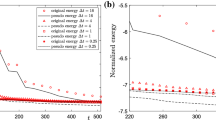Summary
The analytical solution of a linear barotropic model is derived, including details of the quasi-geostrophic initialization procedure. The prognostic equations are integrated using three different methods of treating the meteorological and gravitational modes separately. These are a semi-Eulerian, semi-implicit (EI) technique, a semi-Lagrangian, semi-implicit (LI) procedure, and a split-explicit (SE) method. The stability criteria and phase speeds are derived for each of the three techniques.
The following theoretical conclusions are derived. Of course, in actual numerical integrations particularly those using more complex models, the results are not so unequivocal.
The stability of the EI procedure is governed by the CFL criterion for the meteorological mode. Gravity waves have no effect on the timestep but move more slowly than the analytical waves. The LI method is unconditionally stable with respect to both meteorological and gravitational modes. There is thus no timestep restriction. However, the gravity waves have the same reduced phase speed as in the EI technique. The SE procedure has CFL timestep criteria for both the meteorological and gravitational calculations. However, its gravity wave phase speeds are relatively accurate. Moreover, it is the only one of the three methods that handles the nearly-compensating pressure gradient and Coriolis forces together. From the point of computational efficiency, the LI technique is probably the best.
Similar content being viewed by others
References
Collins, W. G., 1980: A comparison of explicit and semi-implicit model calculations of geostrophic adjustment.Mon. Wea. Rev.,108, 1390–1401.
Gallée, H., Schayes, G., 1994: Development of a three-dimensional meso-γ primitive equation model: Katabatic wind simulation in the area of Terra Nova Bay, Antarctica.Mon. Wea. Rev.,122, 671–685.
Haltiner, G. J., Williams, R. T., 1980:Numerical Prediction and Dynamic Meteorology. New York, Chichester, Brisbane, Toronto: John Wiley and Sons, 477 pp.
Kar, S. K., Turco, R. P., Mechoso, C. R., Arakawa, A., 1994: A locally one-dimensional semi-implicit scheme for global grid point shallow-water models.Mon. Wea. Rev.,122, 205–222.
Krishnamurti, T. N., 1962: Numerical integration of primitive equations by a quasi-Lagrangian advective scheme.J. Appl. Meteor.,1, 508–521.
Kurihara, Y., 1965: On the use of implicit and iterative methods for the time integration of the wave equation.Mon. Wea. Rev.,93, 33–46.
Kwizak, M., Robert, A. J., 1971: A semi-implicit scheme for grid point atmospheric models of the primitive equations.Mon. Wea. Rev.,99, 32–36.
Marchuk, G. I., 1974:Numerical Methods in Weather Prediction.: New York, London: Academic Press, 277 pp. (Translated from the Russian edition published in 1967).
Mesinger, F., Arakawa, A., 1976: Numerical Methods Used in Atmospheric Models, Vol. I. GARP Publication Series No. 17, August 1976, World Meteorological Organization, Geneva, Switzerland, 64 pp.
Phillips, N. A., 1960: On the problem of initial data for the primitive equations.Tellus,12, 121–126.
Purser, R. J., Leslie, L. M., 1994: An efficient semi-Lagrangian scheme using third-order semi-implicit time integration and forward trajectories.Mon. Wea. Rev.,122, 745–756.
Robert, A. J., 1979: The semi-implicit method. In:Numerical Methods Used in Atmospheric Models, Vol. II, GARP Publical Organization, Geneva, Switzerland, 419–439.
Robert, A. J., 1981: A stable numerical integration scheme for the primitive meteorological equations.Atmos.-Ocean,19, 35–46.
Rivest, C., Staniforth, A., Robert, A., 1994: Spurious resonant response of semi-Lagrangian discretizations to orographic forcing: Diagnosis and solution.Mon. Wea. Rev.,122, 366–376.
Author information
Authors and Affiliations
Rights and permissions
About this article
Cite this article
Danard, M., Wang, X. Numerical integration of a linear barotropic model using three methods of treating meteorological and gravitational modes separately. Meteorl. Atmos. Phys. 58, 1–11 (1996). https://doi.org/10.1007/BF01027552
Received:
Revised:
Published:
Issue Date:
DOI: https://doi.org/10.1007/BF01027552




